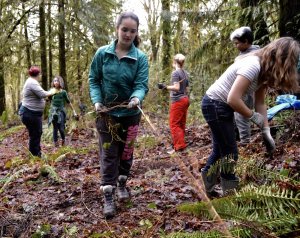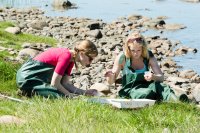A Place-Based Approach to PBL
A veteran teacher and author discusses how to bring fieldwork into your project-based learning curriculum.
Your content has been saved!
Go to My Saved Content.Connecting students with issues, experts, and allies right in their own backyard is a surefire strategy to make project-based learning (PBL) more accessible and immediate. Students can meet academic goals by doing things like investigating access to neighborhood parks, mapping local food deserts, or telling the stories of people who help to give a place its identity. They become more engaged citizens who understand “how everyone and everything in a community is interconnected,” according to educator and author Sarah Anderson.
Anderson is a veteran teacher and coordinator of fieldwork and place-based education at Cottonwood School of Civics and Science, a K–8 public charter school in Portland, Oregon. She’s also the author of a new book, Bringing School to Life: Place-Based Education across the Curriculum, that is full of practical strategies for turning any community into a learning lab.
She shared some highlights in a recent conversation.
EDUTOPIA: How did you become an advocate of this community-centered approach to PBL, which you describe as place-based education?
SARAH ANDERSON: After college (I was an American Studies major), I came to Portland with AmeriCorps. My project was about getting people to embrace public land and take care of it. That got me thinking about, how do you foster democracy and promote the public good? I kept coming back to education. Eventually, I went to graduate school at Antioch University specifically to study with David Sobel, an expert in place-based education.
EDUTOPIA: At Cottonwood School of Civics and Science, you’ve been able to put theory into practice. Tell us about the school and your role there.
ANDERSON: The school had only been open a year when I arrived in 2008 to develop the middle school program. It was started by a group of parents whose neighborhood school had closed. Getting a public charter school started taught them a lot about what it means to be civically engaged, and they brought that idea into the school mission. Today, the school has about 200 students from K to 8. Students take part in at least three in-depth projects in each grade, often in collaboration with a community partner.
After six years teaching middle school humanities, I took on a new role as coordinator of fieldwork and place-based education. Now I work with teachers to help them learn about place-based education and design projects, and do outreach to connect with community partners. I also do professional development with teachers from other schools.
EDUTOPIA: What questions do you hear most often from teachers who are new to place-based education?
ANDERSON: The biggest struggle seems to be with integrated learning. Our traditional system has content all siloed and segregated, and teachers have been trained to teach that way. It feels easier to organize and control. But that’s not the way the world works, and you can’t do project-based learning (or place-based education) that way.
Some teachers also wonder about schedule. They’ll ask, “When do I have time in the day to do projects?” It takes time for them to see that projects aren’t something you add to the curriculum—projects are the curriculum.
Some teachers are uncomfortable reaching out to potential partners. They’re good at working with children, but forging relationships with organizations may not be their forte. I spend about a third of my time now on outreach.
EDUTOPIA: Your school emphasizes fieldwork instead of field trips. What’s the difference?

ANDERSON: Field trips are often little additions or treats at the end of a unit. Fieldwork is the way our students gather information. They approach fieldwork with a specific focus or set of questions they want to answer. Their work might involve surveys, observations, interviews, or data collection.
Our third graders create an exhibit every year for an Archaeology Roadshow. In preparation, they visit a local museum and learn from professional curators about how to make a good exhibit.
Our seventh and eighth graders are finishing a pop-up museum about immigration that will be installed temporarily at the Portland Mercado, a public market serving the Latino community. They visited another pop-up museum, interviewed museum designers, and kept journals to record what they were learning. On the content side, they spoke with an immigration lawyer and other experts to understand current issues like DACA and sanctuary cities. Their exhibit will help to inform visitors to the Mercado about these issues.
EDUTOPIA: How much choice do students have in these kinds of projects?
ANDERSON: Our projects are designed by teachers, often in collaboration with a community partner. We design projects to build certain skills that cross disciplines and grade levels—such as knowing how to do research—and also to meet specific content standards. Some projects are used again and again, with slight updates. Students do Project Citizen, for example, in both seventh and eighth grades.
So students aren’t necessarily coming up with the project ideas themselves. But within each project, students make decisions about what they will create and, sometimes, which role they want to take. For the pop-up project, students could apply to be curators, researchers, fact checkers, art makers, cartographers, or documentarians. In the same project, there were learning activities that everyone was doing to build background knowledge. For example, they all read the same book, Enrique’s Journey, and mapped the difficult journey that the main character made through Central America and Mexico on his way to the United States.
EDUTOPIA: What advice would you offer to schools interested in place-based education?
ANDERSON: Be patient. It takes time for teachers to get comfortable teaching this way. It also takes time to develop relationships with community partners.
But the investment is worth it if we want to help kids grow into people who are compassionate and caring and want to take care of others. There are plenty of serious challenges in our world that our students will face. How will they even start? Tackling local problems is way more realistic. You can often make change faster at the local level.
